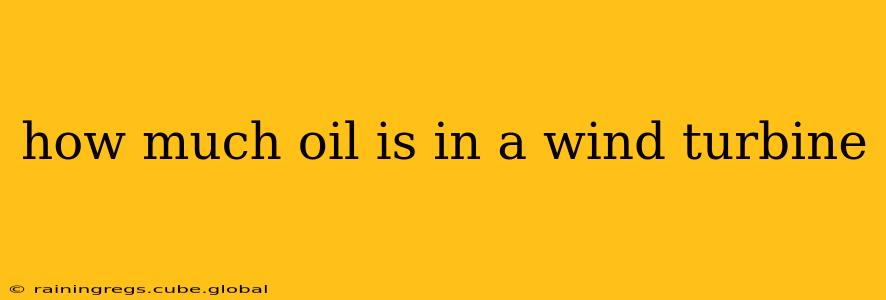How Much Oil is in a Wind Turbine? A Surprisingly Significant Amount
The question of how much oil is in a wind turbine might surprise you. While wind energy is often touted as a clean and green energy source, the reality is that significant amounts of oil-based lubricants are used in their operation. The exact amount varies considerably depending on the size and type of turbine, its age, and the manufacturer's specifications. However, we can explore the different components and provide a reasonable estimate.
What are the sources of oil in a wind turbine?
Oil isn't used as fuel in a wind turbine; instead, it plays a crucial role in lubrication and hydraulic systems. Here are the main components containing oil:
-
Gearbox: Large wind turbines use gearboxes to increase the rotational speed of the low-speed shaft from the rotor to the high-speed shaft connected to the generator. These gearboxes require substantial amounts of specialized, high-quality lubricant oil to prevent wear and tear under immense pressure and stress. This is often the largest single source of oil within a turbine.
-
Hydraulic Systems: Many wind turbines utilize hydraulic systems for various functions, including blade pitch control, braking mechanisms, and yaw control (orienting the turbine to face the wind). These systems rely on hydraulic oil to transmit power and facilitate smooth operation.
-
Generator Bearings: The generator itself contains bearings that need lubrication to function correctly. These bearings, while using less oil than the gearbox, still contribute to the overall oil quantity.
-
Other Components: Smaller amounts of lubricating oil are also found in other moving parts throughout the turbine, including various shafts and other mechanical components.
How much oil are we talking about?
Estimating the exact amount of oil in a wind turbine is difficult without knowing the specific model and its maintenance history. However, a reasonable estimate for a large, modern onshore wind turbine could range from 50 to 200 liters (13 to 53 gallons). Smaller turbines would naturally contain less, while very large offshore turbines might require even more. This oil needs to be replaced periodically as part of routine maintenance.
What kind of oil is used?
The oil used in wind turbines is not your typical motor oil. It's specially formulated to withstand extreme temperatures, high pressures, and demanding operational conditions. These specialized lubricants are designed to ensure optimal performance and extend the life of the turbine's components.
What happens to the used oil?
Responsible wind turbine operators follow strict procedures for handling used oil. This used oil is collected and sent for proper recycling or regeneration, minimizing its environmental impact. This process helps reduce waste and contributes to sustainability efforts.
Are there alternative lubricants?
Research and development are ongoing to explore more sustainable alternatives to traditional oil-based lubricants in wind turbines. Bio-based lubricants and other synthetic options are being investigated, but they need to meet the same stringent performance requirements as conventional oils before widespread adoption is feasible.
Does the amount of oil negate the environmental benefits of wind energy?
While the presence of oil in wind turbines is a factor, it's essential to consider the overall environmental benefits of wind energy. Compared to fossil fuel-based power generation, the environmental impact of wind energy, including the oil used in turbines, remains significantly lower. The lifecycle assessment of wind energy consistently shows substantial reductions in greenhouse gas emissions and other pollutants.
The amount of oil in a wind turbine is a relevant detail, highlighting the need for responsible maintenance and exploration of alternative lubricants. However, it shouldn't overshadow the undeniable environmental advantages of wind energy as a crucial part of a sustainable energy future.
